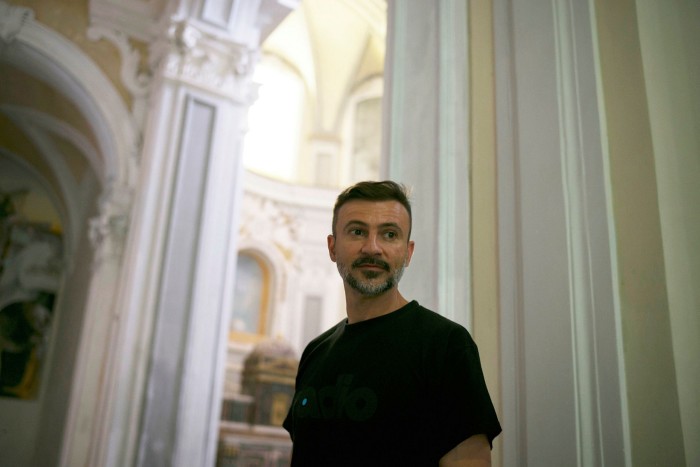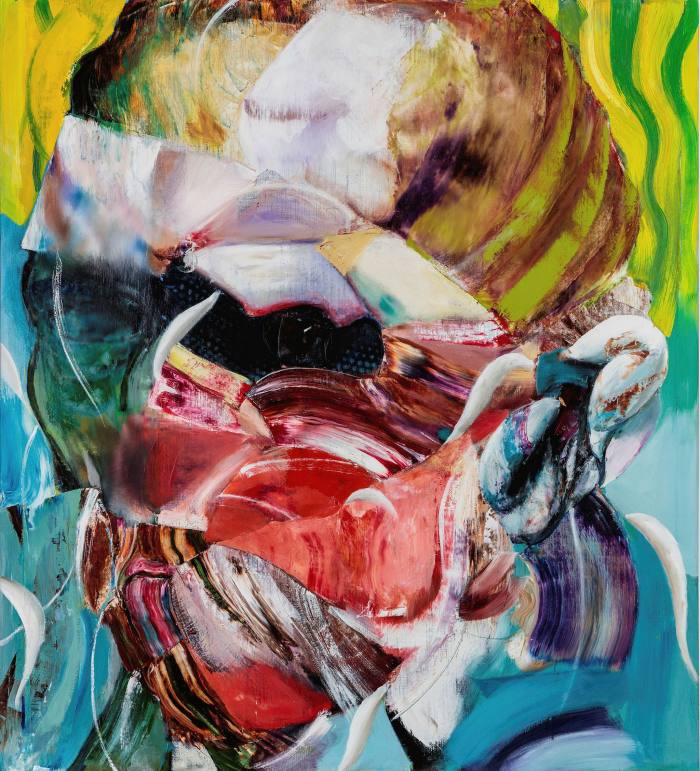

The work of the Romanian painter Adrian Ghenie is certainly high on impact. It hits you right between the eyes, and somewhere in the stomach. His roiling canvasses, with figures and faces often worked into a frantic abstraction, have the colour charge of the Renaissance and Baroque paintings he loves, the narrative of Delacroix, tiny details sucked out of Flemish scenes, and nods to Van Gogh, Courbet and Rousseau, all played out in a multiple layering of imagery, much of it dragged from the internet.
You could say he makes art about art. Before he paints, he creates elaborate paper collages, moving images around until he finds the perfect fit. “It’s like working with Lego,” he says. “It has to all come together.” Then he works intensively and alone in his Berlin studio, producing no more than 15 pieces a year.
Now two major paintings he made in 2019 and 2020 can be seen in the Chiesa della Madonna della Mazza in Palermo. The 17th-century church is on the city’s busy via Maqueda, surrounded by shops selling slices of pizza, shoes, spectacles and shiny dresses. The huge canvasses, custom-made to fit the arched chapels on either side of the altar, seem at first glance to conform to the traditional subjects of religious art, and to be stylistically in sympathy with the church’s baroque architecture. “I wanted,” says Ghenie, “to play right into the fabric of the building.”
Move closer, though, and something more surprising begins to emerge. If we have become immune to the blood and guts of historic religious art, then Ghenie might just be jolting us out of our apathy. “These images are taken from real life,” he says.
On the left are two figures, each lashed to a cross, one bundled in a bright orange body bag; another clad in Adidas track pants. They are victims of Christian crucifixions carried out in Syria in 2015. On the right is Padre Pino Puglisi, the Catholic priest murdered by the mafia in Palermo in 1993. As he faces his assassin, his dignified stance — hand outstretched — is that of Saint Augustine in Michael Pacher’s painting of Saint Augustine and the devil from 1483; behind him are the public housing and corrugated fencing of the poor Brancaccio neighbourhood where he preached and fell.
“I wanted Baroque, Classical,” says Ghenie, “but with a journalistic, cinematic feel.” The devil, who holds the gun, is dressed in a lemon-yellow puffer jacket. “The colour of jealousy,” says the artist. Beneath him is a swirling, intestinal mass.
The church was built between 1603 and 1606, as a place of respite for the city’s poor. Like many others in the Sicilian city, it had been empty and abandoned for 40 years. But when Ghenie met Italian writer and curator Alessandra Borghese (of the aristocratic Borghese family) at a dinner in Paris in 2017, he told her about his desire to make a painting in a church. “I wanted to follow in the path of Caravaggio and Michelangelo, to create something for eternity,” he says.
Borghese, who lives between Rome, Paris and also Palermo — and, thanks to her grandmother, Principessa Sofia Lanza di Trabia, is a quarter Sicilian — enlisted the support of Father Giuseppe Bucaro. The genial director of the Cultural Heritage Department of the Archdiocese of Palermo helped her find a suitable church, while Ghenie’s gallerist, Thaddaeus Ropac, also offered his support. “The first church we saw was like a garage with an altar in it,” says Ghenie. “Then we came here, and I saw the two chapels and I knew it was right.”


The Chiesa della Madonna della Mazza took almost three years to renovate and now, painted in pale grey, white and yellow, has fully regained its baroque elegance. Its original artworks, including those by artists Battistello and Zoppo di Gangi, are undergoing restoration; another by the School of Caravaggio has been reinstalled in its original spot, to the right of Padre Puglisi.
The church officially reopens to the citizens of Palermo on June 9, although in recent months the doors have sometimes been ajar and passers-by seem magnetically drawn inside by Ghenie’s artworks, which literally glow at the end of the nave. When I visited with Ghenie and Borghese, several locals entered, examined the paintings closely and at length, then fell to their knees to pray.
“So many Palermitans will come here and remember their own losses,” says Borghese. “Though my mother was anxious about the gun,” she says of the solid black pistol in the assassin’s hand. “But that’s the tool that delivers today’s martyr,” continues Ghenie. (Puglisi was beatified in 2013 by the Catholic Church.)
Ghenie was born in the small Romanian town of Baia Mare in 1977, during the communist dictatorship of Nicolae Ceausescu. “Palermo is like Bucharest in the 1980s,” he says. “Not everything has been rebuilt in shiny, plasticky materials. Though Palermo is more sensuous. It’s very southern and textured.” Borghese describes it as an open city, on the edge of Europe, outward-looking, tolerant and inclusive.
His family are Orthodox Christians but religion has never played a large part in his life, nor has communism. “People expect communism to be tumultuous, but it’s incredibly quiet,” he says. “We lived in a sort of silence. When Ceausescu was overthrown in 1989, it became even more quiet.”
He attended art school in the northwestern city of Cluj, having sold his first painting at the age of 16. “I rented a space and put on a show,” he tells me. “I sold seven works — winter landscapes — for $50 each. I just wanted people to see my work.” By the time he was 39, his paintings were selling at international auction houses for more than £3mn.
Last month, at Sotheby’s in New York, a work called “Degenerate Art”, made in 2016, sold for more than $9mn. In it he has reworked the famous 1889 self-portrait of Van Gogh, with its pastel blue and green tones, into a riot of yellow, violet and red, synthesising his own painterly self with that of the troubled Dutchman.
Such eye-watering prices can complicate a painter’s career, particularly one who wants to be judged on their art, not their public presence. “The sort of success that comes with the art world is better suited to extroverts,” says Ghenie, who would rather be in his studio than in the spotlight. With this project, he has wriggled out of that system: the paintings in the Chiesa della Madonna will never be on sale. “First and foremost, this is a gift to the people of Palermo,” says Borghese.
Nonetheless, the art world will come, just as they go to see the Rothko Chapel in Houston and the Chapelle du Rosaire in Vence with its murals and windows by Henri Matisse. “It will make the city a place of artistic pilgrimage,” says Borghese, who has already worked hard to put it on the cultural map. (She staged the first African opera, with a libretto in Sahel dialects, at the Teatro Massimo in 2018.) Ghenie, though, will be back in his studio, palette knife in hand, researching his next project, applying paint to canvas, making us think.
Find out about our latest stories first — follow @ftweekend on Twitter
Stay connected with us on social media platform for instant update click here to join our Twitter, & Facebook
We are now on Telegram. Click here to join our channel (@TechiUpdate) and stay updated with the latest Technology headlines.
For all the latest Art-Culture News Click Here


